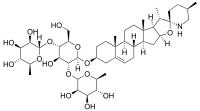Solamargine
| Solamargine | |
|---|---|
 | |
| IUPAC name (3β,22α,25R)-Spirosol-5-en-3-yl 6-deoxy-α-L-mannopyranosyl-(1→2)-[6-deoxy-α-L-mannopyranosyl-(1→4)]-β-D-glucopyranoside | |
| Other names Solamargin; δ-Solanigrine | |
| Identifiers | |
| CAS number | 20311-51-7 |
| PubChem | 73611 |
| ChemSpider | 66278 |
| ChEMBL | CHEMBL443114 |
| Jmol-3D images | {{#if:O([C@H]8[C@H](O[C@@H]5C/C4=C/C[C@H]3[C@@H]6C[C@@H]2O[C@@]1(NC[C@H](C)CC1)[C@@H](C)[C@@H]2[C@@]6(C)CC[C@@H]3[C@@]4(C)CC5)O[C@H](CO)[C@@H](O[C@@H]7O[C@@H](C)[C@H](O)[C@@H](O)[C@H]7O)[C@@H]8O)[C@@H]9O[C@H]([C@H](O)[C@@H](O)[C@H]9O)C|Image 1 |
| |
| |
| Properties | |
| Molecular formula | C45H73NO15 |
| Molar mass | 868.06 g mol−1 |
| Except where noted otherwise, data are given for materials in their standard state (at 25 °C (77 °F), 100 kPa) | |
| Infobox references | |
Solamargine is a poisonous chemical compound that occurs in plants of the Solanaceae family, such as potatoes, tomatoes, and eggplants.[1][2] It is a glycoalkaloid derived from solasodine.
Solamargine was one component of the unsuccessful experimental cancer drug candidate Coramsine.
See also
References
- ↑ Al Chami, L.; Mendez, R.; Chataing, B.; O'Callaghan, J.; Usubilliga, A.; Lacruz, L.; "Toxicological effects of α-solamargine in experimental animals", Phytotherapy Research, 2003, vol. 17, no.3, pp.254-258
- ↑ Blankemeyer, JT.; McWilliams, ML.; Rayburn, JR.; Weissenberg, M.; Friedman, M. (May 1998). "Developmental toxicology of solamargine and solasonine glycoalkaloids in frog embryos.". Food Chem Toxicol 36 (5): 383–9. PMID 9662413.